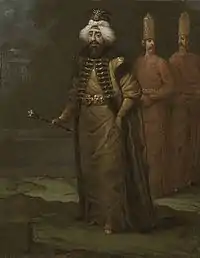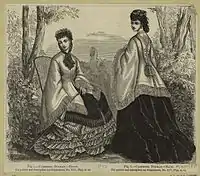dolman
English
WOTD – 27 September 2016
Etymology

Jean Baptiste Vanmour, Portret van Sultan Ahmed III (Portrait of Sultan Ahmed III, 1703–1717), collection of the Rijksmuseum, Amsterdam, the Netherlands. The Sultan of the Ottoman Empire is depicted wearing a dolman (sense 1).

An 1831 portrait by Georg Philipp Schmitt of Count György Károlyi de Nagykároly, a Hungarian politician, wearing a dolman (sense 2)

An illustration by Laure Noël from an 1871 edition of Harper's Bazaar showing the front and back of a cashmere dolman (sense 3)
Apparently from French doliman, dolman (sense 2), ultimately from Turkish dōlāmān, ḍōlāmah, from Ottoman Turkish دولامان (dolaman, “robe”), from طولامق (dolamak, “to wrap around”). Compare German doliman, dollman; Hungarian dolmány.
Pronunciation
- (Received Pronunciation) IPA(key): /ˈdɒlmən/
- (General American) IPA(key): /ˈdoʊlmən/
- Hyphenation: dol‧man
Noun
dolman (plural dolmans)
- A long, loose garment with narrow sleeves and an opening in the front, generally worn by Turks.
- 1903, Maurus Jókai; R[obert] Nisbet Bain, transl., “Three Men”, in The Slaves of the Padishah: (“The Turks in Hungary,” being the Sequel to “Midst the Wild Carpathians”): A Romance, 3rd edition, London: Jarrold & Sons, 10 & 11, Warwick Lane, E.C., OCLC 11540166, page 33:
- Feriz Beg, on discarding his dolman, rolled up the sleeves of his fine shirt of Turkish linen to his shoulders, and drew from its sheath his fine Damascus scimitar, which was scarce two inches broad, and so flexible that you could have bent it double in every direction like a watch-spring.
- 1980, Katalin Földi-Dózsa, “How the Hungarian National Costume Evolved”, in Polly Cone, editor, The Imperial Style: Fashions of the Hapsburg Era: Based on the Exhibition, Fashions of the Hapsburg Era, Austria-Hungary, at the Metropolitan Museum of Art, December 1979—August 1980, New York, N.Y.: Metropolitan Museum of Art, →ISBN, page 80:
- The quintessentially Hungarian item of men's clothing was the dolman. This flowing garment, open in the front, replaced the waistcoat after the Renaissance.
-
- A short, close-fitting, heavily braided military jacket, usually worn under a pelisse, originally by hussars.
- 1983, Roberta Gellis, Fortune's Bride, New York, N.Y.: Dell Publishing, →ISBN:
- Robert nodded in reply to her question and not only took off his helmet but unhooked his pelisse, threw it on a chair, and unbuttoned the top of his dolman.
- 1998, Gayle Greeno, Sunderlies Seeking (DAW Book Collectors; no. 1103), New York, N.Y.: DAW Books, →ISBN:
- Sitting on the chair's edge, he shrugged a shoulder until his dolman fell into place, then balanced his helmet on his knee like a pampered pet.
- 2005, Wilbur [Addison] Smith, The Triumph of the Sun, London: Macmillan Publishers, →ISBN:
- He wore his dolman slung over one shoulder and clasped at his throat with a gold chain, and carried his Hussar's bearskin busby under his right arm.
- 2015, “dolman”, in Annette Lynch and Mitchell D. Strauss, editors, Ethnic Dress in the United States: A Cultural Encyclopedia, Lanham, Md.: Rowman & Littlefield, →ISBN, page 103:
- The uniform jacket with several rows of buttons and a horizontal braid across the front originally worn by the Hussars was also called a dolman.
-
- A woman's garment with wide capelike sleeves.
- 1942, Emily Carr, “A Little Town and a Little Girl: Characters”, in The Book of Small (Project Gutenberg Australia; eBook no. 0400201.txt), Toronto: Oxford University Press, published February 2004 (Project Gutenberg Australia version), OCLC 1317302, archived from the original on 31 March 2016:
- She, who never went out, found a bonnet that I had never seen before, put a dolman over her best silk dress, locked the guinea fowl safe in her kitchen and got into a hack with Henry, her smelling-bottle and her cap, in which was a new bunch of everlasting flowers.
- 1978, Jane Gardam, God on the Rocks, Abacus 2014, p. 162:
- She turned slowly – she was dressed in tussore and a dolman.
- 2011, Lisa Shroyer, “The Dolman Sweater”, in Knitting Plus: Mastering Fit + Plus-Size Style + 15 Projects, Loveland, Colo.: Interweave Press, →ISBN, page 141:
- In general, dolmans are recognizable for their winged kimono-like sleeves and T shape. But the one truism about dolmans is this—there is no standard!
- 2015, “dolman”, in Annette Lynch and Mitchell D. Strauss, editors, Ethnic Dress in the United States: A Cultural Encyclopedia, Lanham, Md.: Rowman & Littlefield, →ISBN, page 103:
- The dolman mantle, a popular women's fashion in Western Europe and the United States during the 1870s and 1880s, was characterized by loose sling-like sleeves cut with the body of the garment resembling a half jacket, half cape.
-
Usage notes
Not to be confused with dolmen.
Alternative forms
- dollman (obsolete)
Homonyms
References
- “dolman”, in The American Heritage Dictionary of the English Language, 4th edition, Boston, Mass.: Houghton Mifflin, 2000, →ISBN, archived from the original on 12 April 2001.
This article is issued from Wiktionary. The text is licensed under Creative Commons - Attribution - Sharealike. Additional terms may apply for the media files.